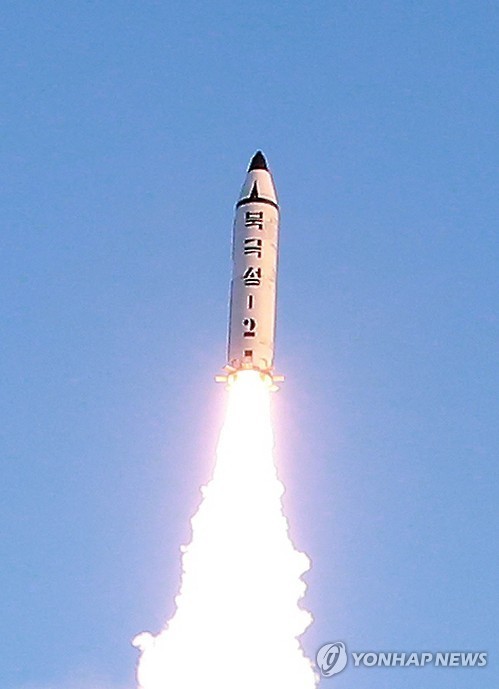A senior South Korean lawmaker on Tuesday called for a revision to the missile defense system sought by the country by the mid-2020s as North Korean missiles will likely become harder to detect before launch.
The upcoming "kill chain" strike system and the Korean Air and Missile Defense system are both designed to detect and destroy incoming missiles in the shortest possible time.
 |
In this captured image from North Korea's state-owned Korean Central News Agency, the Pukguksong-2 missile flies after being fired from a mobile launcher in an air base on Feb. 12, 2017. (Yonhap) |
In a meeting with reporters after being briefed on North Korea's latest missile launch and Seoul's countermeasures by the National Intelligence Service, Lee Cheol-woo, chairman of the National Assembly's Intelligence Committee, raised questions about the effectiveness of the anti-missile systems in hitting the North's newly developed solid-fuel missile fired from a mobile launcher on Sunday.
"With the planned systems, it is impossible to pre-emptively strike solid propellant missiles (through prior detection). So the kill chain (and KAMD) systems themselves don't make an effective missile defense system," he told reporters.
Solid-fuel missiles pose a greater threat as they require less preparation time than liquid-fueled rockets, and can be fired more easily and quickly from a mobile launcher.
It takes about one to three hours for the North to fuel a liquid-fueled missile, so it can be detected by surveillance satellites operated by the US and South Korea. In that case, a pre-emptive strike is possible, according to military officials.
Most of North Korean ballistic missiles, such as the shorter-range Scud with a range of 500-700 kilometers, the medium-range Rodong with a 1,300-1,500 km range and the intermediate-range Musudan missile with a range of more than 3,000 km, use liquid fuel.
But the surface-to-surface intermediate-range Pukguksong-2 missile launched by the North Sunday has been determined by the military as a solid fuel type. It is speculated to have a range of more than 2,000 km.
As it was launched at a high angle, the missile reached a height of 550 km and flew about 500 km before splashing down into the East Sea.
"It takes only five to 10 minutes to launch the solid-fuel Pukguksong-2," Lee said.
North Korean leader Kim Jong-un likely ordered the task of developing the Pukguksong-2 missile based on the successful SLBM test carried out in August, Seoul's Joint Chiefs of Staff said Sunday.
The SLBM launched in August carried the name Pukguksong-1, a name which translates as the "North Star."
As for anti-missile capabilities, the PAC-2 and PAC-3 Patriot systems currently operated by the U.S. Forces Korea and the Korean military are up to the task of intercepting the Pukguksong-type missiles, the chairman said.
The PAC-2 and PAC-3 are designed to intercept missiles for a "low altitude" of 20-40 km.
"Given the Patriot missile defense systems are designed to strike incoming missiles travelling at speeds of Mach 8-9, they may not be effective in shooting down an incoming missile at speeds of Mach 9-10," he said.
On Tuesday, the NIS confirmed the Pukguksong-2 reached a maximum speed of Mach 10.
Missile experts say if a missile reaches a height of 550 km and falls, it can reach very high speeds. This means the kill chain and KAMD won't work properly in the face of an incoming missile from the North, they said.
The Terminal High Altitude Area Defense missile defense system, scheduled to be deployed in South Korea this year, may also ineffective in dealing with high speed missiles,
THAAD is known to be able to intercept a missile flying 40-150 km from the ground, can shoot down missiles that comes directly towards it even if they reach speeds of Mach 14, but are less effective for missiles heading for distant areas.
Yoo Seung-min, a presidential candidate for the conservative Bareun Party, argued South Korea needs to "inject a defense budget to secure two to three THAAD batteries here and have control over missile defense operations." (Yonhap)




![[Herald Interview] 'Trump will use tariffs as first line of defense for American manufacturing'](http://res.heraldm.com/phpwas/restmb_idxmake.php?idx=644&simg=/content/image/2024/11/26/20241126050017_0.jpg)


![[Health and care] Getting cancer young: Why cancer isn’t just an older person’s battle](http://res.heraldm.com/phpwas/restmb_idxmake.php?idx=644&simg=/content/image/2024/11/26/20241126050043_0.jpg)
